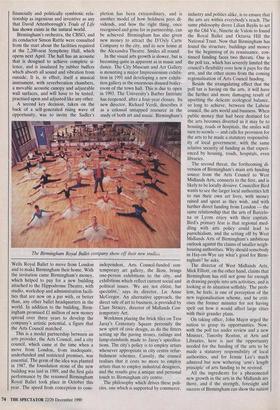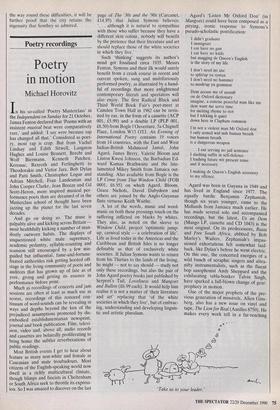ARTS
The fine art of revival
James Hamilton investigates Birmingham's cultural renaissance
At the heart of Birmingham, hidden amongst the walkways beneath the Bull Ring, is a text set up in 16-inch high capital letters which could be read as the city's mantra. Discreetly reserved but there to be seen, it suggests that if anybody professes surprise at Birmingham's cultural resurg- ence they should reread the Romantic poets. The words are Robert Southey's, written in 1807:
Probably in no other age or country was there ever such an astonishing display of human ingenuity as may be found in Birm- ingham. In the late 1970s Birmingham's ingenuity faced its stiffest test when the recession hit the car industry. These were the days when Red Robbo climbed on to the back of a lorry to harangue the car workers, when Michael Edwardes made his tortured tele- vision appearances and when flying pickets warmed their hands at braziers at the factory gate. Overnight the belief in the unbreakability of Birmingham crashed, and its high employment rate fell, or climbed, to the highest unemployment rate in the country. This disaster, however, created Birming. ham's greatest opportunity, a peacetime equivalent of those that the Blitz had created for many British cities to clear away slum housing. While the newspapers were discussing the 1981 riots in Toxteth, Brixton and Handsworth, and Michael Heseltine was swinging into action with his Garden Festival plan for Liverpool, Birm- ingham had already decided upon the solution to its problems, and by 1982 its new cultural policy was in place. Birmingham's reflowering is of the perennial kind, with slower germination but deeper roots. It has become a model to ambitious cities, and suggests that the city councillors have been rereading their Southey inscription. In effect, Birmingham has completely reorganised its city centre, to make an island of culture stretching from the City Museum and Art Gallery in the east to the new International Conven- tion Centre and Symphony Hall in the west. In between is the city library, the repertory theatre and a new open space, Centenary Square, laid out with a floor resembling a huge magic carpet, designed by Tess Jaray. Acting as a central hub is the Hall of Memory built to honour the dead of two world wars.
When President Pompidou built the Pompidou Centre on the site of the old Paris meat market, butchers threatened to riot; when Ceausescu remodelled the cen- tre of Bucharest, God knows how many people were made homeless. But when Birmingham makes its equally radical changes, nobody seems to get upset. Even the man on the Edgbaston omnibus (as reported to the director of museums) says: `You can say what you like about this council, but they've done a good job here.' So what's so special about Birmingham? John Barker, the chairman of West Mid- lands International and Merchant Banking Association, calls it a sleeping beauty, while councillor Bryan Bird, chairman of the city's leisure services committee, likens it to a waking giant. Differences of gender and bulk notwithstanding, the two images have a kindred meaning, and show mer- chant bankers and Labour politicians to be speaking unexpectedly with one voice.
The key decision, and the financial catalyst for the renaissance, was that taken to build the Symphony Hall at the heart of the new £160-million International Con- vention Centre. The bulk of this money has been borrowed through the money mar- kets by the Convention Centre's parent company, NEC Ltd, while the balance, £49.7 million, was given by the European Regional Development Fund. NEC Ltd is owned jointly by Birmingham city council and the city's Chamber of Commerce, with the city council guaranteeing and ultimate- ly repaying the loan at a low fixed interest rate. In turn, the Convention Centre will repay the council from the fees earned through the hiririg by trade and industry of its halls and services. The ICC manage- ment is bouncing with confidence that, by 1995-96, the 'optimum utilisation year', as they put it, the Centre will be repaying the city council handsomely. So no wonder merchant bankers and Labour politicians are speaking with one voice: through a clever arrangement of silent sponsorship, the Symphony Hall, one of the gleaming attractions for users of the Centre and a new focus for music in Britain, will both create and dine on the fruits of the convention trade. This is a
financially and politically symbiotic rela- tionship as ingenious and inventive as any that David Attenborough's Trials of Life has shown exists in the natural world.
Birmingham's orchestra, the CBSO, and its conductor Simon Rattle were consulted from the start about the facilities required at the 2,200-seat Symphony Hall, which opens next April. The hall has an acoustic that is designed to achieve complete si- lence, and is insulated by rubber buffers which absorb all sound and vibration from outside. It is, in effect, itself a musical instrument, with reverberation chambers, a movable acoustic canopy and adjustable wall surfaces, and will have to be tested, practised upon and adjusted like any other.
A second key decision, taken on the back of a self-generated rising wave of opportunity, was to invite the Sadler's The Birmingham Royal Ballet company show off their new studio:; Wells Royal Ballet to move from London and to make Birmingham their home. With the invitation came Birmingham's money, which helped to pay for a new building attached to the Hippodrome Theatre, with studio, workshop and administration facili- ties that are now on a par with, or better than, any other ballet headquarters in the world. In addition to the building, Birm- ingham promised £1 million of new money spread over three years to develop the company's artistic potential, a figure that the Arts Council matched.
This is a model partnership between an arts provider, the Arts Council, and a city council, which came at the time when a move from London, from inadequate, underfunded and restricted premises, was essential. The germ of the idea was planted in 1987, the foundation stone of the new building was laid in 1989, and the first gala performance by the renamed Birmingham Royal Ballet took place in October this year. The speed from conception to corn-
pletion has been extraordinary, and is another model of how boldness pays di- vidends, and how the right thing, once recognised and gone for in partnership, can be achieved. Birmingham has also given new money to attract the D'Oyly Carte Company to the city, and its new home at the Alexandra Theatre. Smiles all round.
In the visual arts growth is slower, but is becoming quite as apparent as in music and dance. The City Museum and Art Gallery is mounting a major Impressionism exhibi- tion in 1991 and developing a new exhibi- tion gallery in the enormous disused boiler- room of the town hall. This is due to open in 1993. The University's Barber Institute has reopened, after a four-year closure. Its new director, Richard Verdi, describes it .as a colossal untapped resource in the study of both art and music. Birmingham's
independent, Arts Council-funded con- temporary art gallery, the Ikon, brings one-person exhibitions to the city, and exhibitions which reflect current social and political issues. We are not elitist, but specialist,' says its director, Lis Anne McGregor. An alternative approach, the direct sale of art to business, is provided by Clare Stracey, director of Midlands Con- temporary Art.
Workmen placing the brick tiles on Tess Jaray's Centenary Square personify the new spirit of civic design, as do the fitters setting up the paving stones, railings and lamp-standards made to Jaray's specifica- tions. The city's policy is to employ artists whenever appropriate in city centre refur- bishment schemes. Cannily, the council realises that it costs no more to employ artists than to employ industrial designers, and the results give a unique and personal touch to Birmingham city centre.
The philosophy which drives these poli- cies, one which is supported by commerce, industry and politics alike, is to ensure that the arts are within everybody's reach. The same philosophy drove Lilian Baylis to set up the Old Vic, Ninette de Valois to found the Royal Ballet and Octavia Hill the National Trust. Now that Birmingham has found the structure, buildings and money for the beginning of its renaissance, con- tinued funding faces two threats. One is the poll tax, which has severely limited the council's flexibility over how it pays for the arts, and the other stems from the coming regionalisation of Arts Council funding.
Beside the strangulating effect that the poll tax is having on the arts, it will have the further and more damaging result of upsetting the delicate ecological balance, so long to achieve, between the Labour council, the arts world and business. When public money that had been destined for the arts becomes diverted as it may be to housing, roads or hospitals, the smiles will turn to scowls — and calls for provision for the arts to be made a statutory responsibil- ity of local government, with, the same relative security of funding as that experi- enced by housing, roads, hospitals, even libraries.
The second threat, the forthcoming di- version of Birmingham's main arts funding source from the Arts Council to West Midlands Arts, connects to the first, and is likely to be locally divisive. Councillor Bird wants to see the larger local authorities left to run their own art lives, with money raised and spent as they wish, and with further direct funding from London — the same relationship that the arts of Barcelo- na or Lyons enjoy with their capitals. Bird's primary fear is that regional med- dling with arts policy could lead to parochialism, and the setting off by West Midlands Arts of Birmingham's ambitious outlook against the claims of smaller neigh- bouring authorities. Why should somebody in Hay-on-Wye say what's good for Birm- ingham? he asks.
The director of West Midlands Arts, Mick Elliott, on the other hand, claims that Birmingham has still not gone far enough in drawing people into arts activities, and is looking at its situation selfishly. The prob- lem, he feels, is one of perception of the new regionalisation scheme, and he criti- cises the former minister for not having spelt out how it would affect large cities with their grander plans.
On taking office, John Major urged the nation to grasp its opportunities. Now, with the poll tax under review and a new Minister, Timothy Renton, at Arts and Libraries, here is just the opportunity needed for the funding of the arts to be made a statutory responsibility of local authorities, and for Jennie Lee's much admired but now withering 'arm's length principle' of arts funding to be revived. All the ingredients for a phenomenal new growth in the arts in the Midlands are there, and if the strength, foresight and success of Birmingham can show the nation the way round these difficulties, it will be further proof that the city retains the ingenuity that Southey so admired.




































































































 Previous page
Previous page